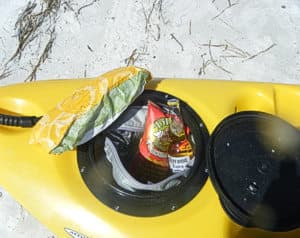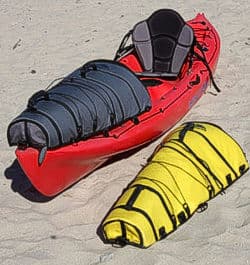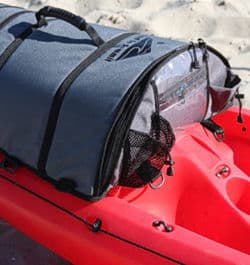This Order is TO GO
For most of my paddle fishing experience, I haven't given much thought to keeping what I catch. There are several reasons for that:
- I rarely catch anything. That's my own fault because I don't "fish" long enough to be good at it. I fish, I paddle, I take pictures, I drift and ponder my next article, I drift and ponder "how the hell did I drift over here?". I'm quickly bored and can always come up with a valid reason why the fish didn't bite on a particular day.
- If I do catch something, I don't keep it because I'm confident I won't catch enough for a family meal (see #1). Let's say I catch a decent spotted sea trout (relatively easy in my part of the world). Ideally, two keepers would be a decent family meal. One however, would not, and they don't freeze well. The last thing I want to do is waste the resource. Corny, but true.
- I'm certainly not prepared to properly keep what I catch. If I don't PLAN to keep a fish for dinner, what happens if I do manage to land that upper slot redfish? My tiny beverage cooler certainly won't hold it, so what do I do?
- Since I don't keep many fish, my filleting skills are lacking. A lousy fillet job is about the same as improperly handing a potential dinner. The result is still a waste of the resource.
Now that I live on the water, I've changed my tune a little. Since we moved, I haven't had many opportunities to fish. You get a new address you have to get your house in order first. Once done, you can get back to doing what you do. But, on those occasions when I've fished here, I always catch fish (yes, every time, so far). And, the main species I reel in are grouper (too small to keep, but …), flounder (certainly big enough to keep), and spotted sea trout - all are great table fare. It's one thing to be a few feet from home when you catch dinner, but it's another when you're out in the summer heat and a long way from home. Planning is key.
ARE YOU FISHING OR CATCHING/KEEPING? Ironically, the end all starts at the beginning. As you get ready to head out, do you make plans to keep what you catch? I can't make that decision, because I'm convinced that if you PLAN to bring home dinner, it ain't gonna happen. But, in an effort to trick the fish gods, there are things we can do.
IMPROVISATION: In my mind, the main thing you need to do with your catch is to keep it cool. If you left shore without a cooler of any sort, you don't even need to consider keeping your catch. I guess if you caught that keeper within sight of your vehicle and a cooler was waiting, that's another story. But if you're like me, you catch one keeper you're not too eager to leave the spot. So, the most simple solution is to always have some sort of cooler, and always have some sort of large bag. It can be a grocery bag, a trash bag, or a large ziplock bag. That will help keep fish goo off of your Mountain Dew. It ain't a pretty solution, but it'll get you through.
ICE, ICE, BABY: To keep the cool, obviously you need ice. I don't use ice anymore - I have a couple alternatives. I freeze water bottles, because when they melt you can drink them. Use good "name brand" water because the bottles are heavier duty and can take being frozen better. I also use those blue freezer blocks and I have every size known to mankind. Neither of these coolants leave water in my cooler, so that means less mess to clean up at the end of the day. Vanilla Ice will be performing at an upscale sushi place near me in a couple of weeks. $10. I'm compelled to go, and I'm not sure why. That song will be in your head for a while now …
THE SAM'S BAG: For less than $10 you can have a great solution to this problem, and, you already have a great storage place for it. Sam's (and many other stores) sell insulated zippered bags to carry home your goods. This is great for us because it will mold nicely to the form of our front hatch. I like to put the bag in my front hatch, then add my frozen water bottles and "whatever" else I might need for the day. You can also toss in a kitchen size trash bag to hold your potential dinner. Yeah, I could just drop it in the bag, but I don't really want slime on my, uh, lunch.

DOING IT RIGHT:
Now if you're dead set on bringing home dinner, you might as well do it right. This, is how to do it right. It's an insulated bag, designed for the bow of your kayak. It can be fastened to your boat in a zillion different ways, has handy pouches, a reusable ice pack, and is designed to be easy to clean. It comes in 24" and 43" models and will set you back $90 to $110. Stop making that face, let's do a little math. If a family of 4 goes to a restaurant for a nice fish dinner, you'll spend close to this and the fish won't be near this fresh. And that's just the ROI on one outing. If you are a keeper, then THIS is a keeper:


Here's the link to learn more about it: Surf To Summit Fish Bag
HOW TO FILLET A FISH PROPERLY, EVERY TIME: OK, that was a trick. In order to properly deconstruct something, you first must understand how it was constructed in the first place. Do some boring internet recon and find the skeletal makeup of your favorite food fish. You might be surprised at what you'll find. You will need a sharp knife, of course. Then, you'll need someone to show you how to do it. YouTube is littered with video on this.
MODERATION: It's always worth saying, "Limit your catch - don't catch your limit." Fresh fish is no longer fresh once it's frozen, so keep just enough for a meal. Besides, that gives you a good excuse to go fish again.
A good day of fishing for me still ends with a big steak on the grill. But I can certainly see some redfish getting the nod in the near future. Anyone have a good recipe?
See you out on the water...
"Many men go fishing all of their lives without knowing that it is not fish they are after" ~ Henry David Thoreau
Related Articles
Learn how to make a pivoting rod holder that will keep your rods out of the way when you don't need them…
Watch and hear the story of how Raf Vargas caught a 170lb dogfish tuna. After hooking it at a depth of…
Wisdom can sometimes be found in some of the strangest places. Recently we made a trip to Key West for a…



